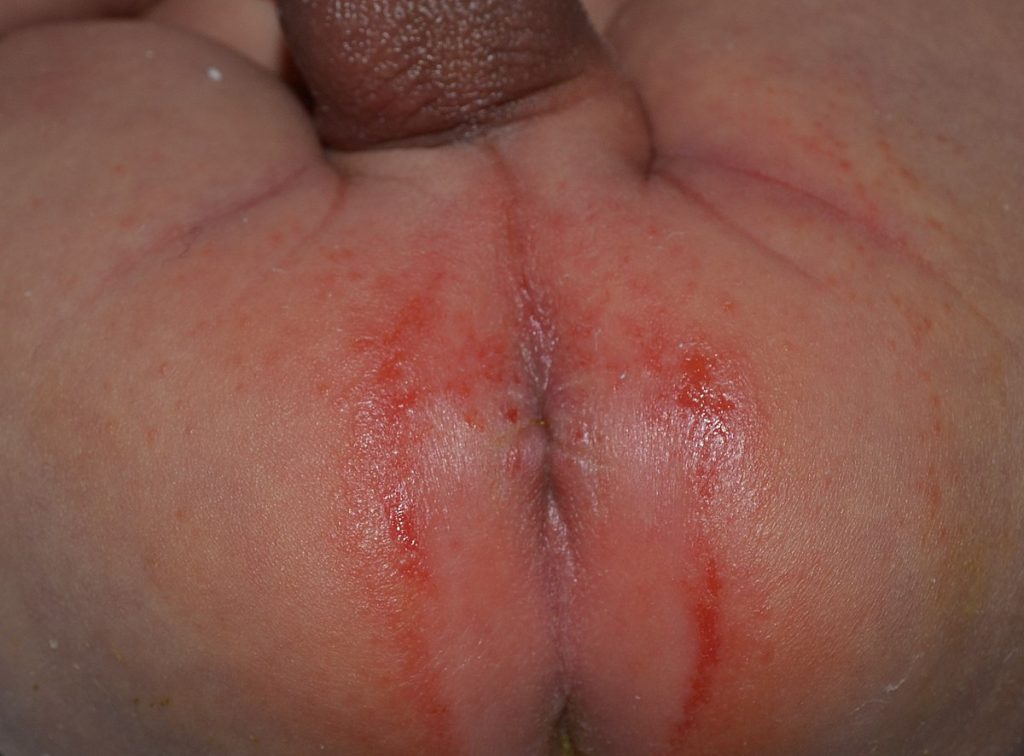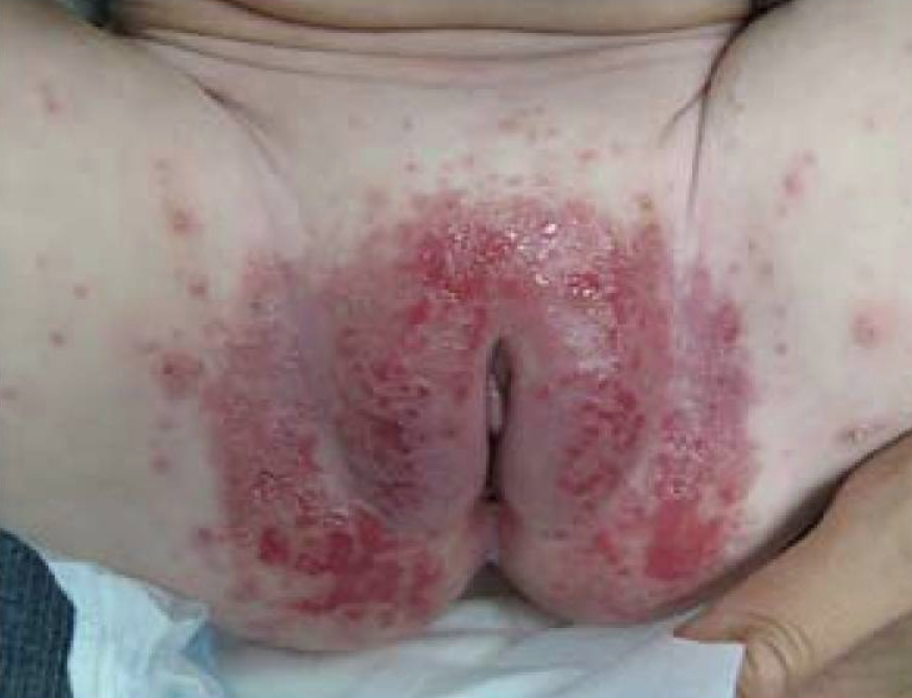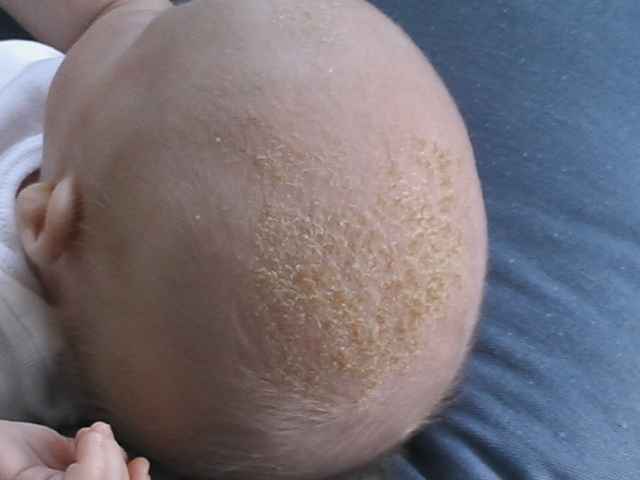16.8 Dermatitis
Dermatitis is a broad term that means inflammation of the skin. This section will focus on two common types of pediatric dermatitis called diaper and seborrheic. Diaper dermatitis, also known as diaper rash, is an inflammation of the skin in the diaper area. Seborrheic dermatitis is an inflammation of the skin in areas containing sebaceous or oil-producing glands. When present on the head, it is commonly known as cradle cap.[1],[2]
Causative factors for diaper dermatitis include an increase in moisture or infrequent diaper changes. Fungal infections with Candida albicans or bacterial infections with Staphylococcus aureus or Streptococcus pyogenes are also causative factors. When caused by an infection with C. albicans, this disorder is sometimes referred to as diaper candidiasis. Diaper dermatitis occurs in up to 50% of infants due to the immaturity of their skin. Other risk factors are diet changes and the pH of the stool. Infants who are breastfed are less likely to experience diaper dermatitis.[3]
The etiology of seborrheic dermatitis is multifaceted, but has been linked to Malassezia, a fungus present in normal skin flora. Infantile seborrheic dermatitis occurs in infants less than three months old, but there is also an adult form of this disorder. Risk factors include male gender, overactive sebaceous glands, and immunodeficiency.[4]
Pathophysiology
When a client wears diapers, trapped moisture leads to skin friction and breakdown. The breakdown of urine on the skin can also increase skin pH. This can increase the activity of enzymes in feces and cause further skin breakdown. Ultimately, these factors increase the susceptibility of the skin to bacteria and fungi and can lead to diaper dermatitis.[5]
The pathophysiology of seborrheic dermatitis is complex and not completely understood. It is currently thought that the skin’s normal flora becomes disturbed and an immune response to Malassezia occurs, which leads to an alteration in the balance of lipids on the infant’s skin surface. There may also be genetic factors at play that increase a client’s risk for the development of seborrheic dermatitis.[6]
Assessment (Recognize Cues)
Physical Exam
In those with diaper dermatitis caused by irritation, the skin is reddened, and lesions or papules may also be present. Skin lesions do not form in skin folds and commonly appear on the thighs, scrotum, buttocks, and pubic areas. See Figure 16.13[7] for an image of diaper dermatitis caused by irritation on the buttocks of an infant. The appearance of diaper dermatitis can also vary based on the causative factors. For instance, with diaper candidiasis, the skin is red and edematous with scaly plaques. The client may also have pustules or papules, and unlike diaper dermatitis, skin folds will be involved.[8] See Figure 16.14[9] for a severe case of diaper candidiasis.


Infantile seborrheic dermatitis commonly appears on the scalp and face, as these regions have many sebaceous glands. However, it can also appear in the diaper area or armpits. When it presents on the scalp as cradle cap, it leads to the formation of a yellow crust that may seem greasy. It usually begins on the front of the scalp but can progress to the entire head. A serous exudate may also be present. Cradle cap may look unpleasant, but it does not cause itching or pain in the infant. However, secondary bacterial infections can occur if the area becomes irritated.[10],[11] See Figure 16.15[12] for an image of cradle cap.

Common Laboratory and Diagnostic Tests
Diaper dermatitis or seborrheic dermatitis is diagnosed clinically. However, a diagnostic test that examines skin scrapings under a microscope may be ordered for confirmation.[13],[14]
Diagnosis (Analyze Cues)
Nursing priorities for clients with dermatitis include symptom management and the prevention of complications. Nursing diagnoses for clients with dermatitis are created based on the specific needs of the client, their signs and symptoms, and the etiology of the disorder. These nursing diagnoses guide the creation of client-specific care plans that encompass client outcomes and nursing interventions, as well the evaluation of those outcomes. These individualized care plans then serve as a guide for client treatment. Possible nursing diagnoses for clients with dermatitis include the following[15]:
- Impaired skin integrity r/t disease process
- Risk for infection r/t impaired skin integrity
Outcome Identification (Generate Solutions)
Outcome identification encompasses the creation of short- and long-term goals for the client. These goals are used to create expected outcome statements that are based on the specific needs of the client. Expected outcomes should be specific, measurable, achievable, relevant, and timebound (SMART) within a set time frame based on the application of appropriate nursing interventions. Sample expected outcomes for clients with diaper dermatitis or seborrheic dermatitis include the following:
- The client will exhibit intact skin that is free from lesions within one week.
- The client will not develop signs of secondary infection during the course of the illness.
Implementation (Take Action)
Medical Interventions
Diaper dermatitis can be managed by healing impaired skin and preventing recurrence of the disorder. This can be done by limiting moisture in the diaper region and ensuring optimal hygiene. Diapers should be changed frequently, and the diaper area should be cleaned with water and a gentle cleanser. Barrier creams should also be applied with each diaper change. If diaper dermatitis does not heal in a few days using these measures, a topical steroid cream may be recommended. Topical antifungals and antibiotics will be needed for fungal or bacterial infections associated with diaper dermatitis.[16]
Medical treatment of cradle cap caused by seborrheic dermatitis encompasses good skin care. The infants should be bathed daily using a gentle shampoo formulated for infants. The scales caused by cradle cap can be removed by applying an emollient such as baby oil, letting it sit overnight, and then rubbing the area with a soft brush. If conservative measures do not improve the cradle cap, topical antifungals or steroids may be prescribed.[17]
Nursing Interventions
Registered nurses develop interventions based on the expected outcomes of the client. Prior to implementation, the nurse must determine if all previously planned interventions are still suitable based on the current situation of the client. When caring for a client with dermatitis, nursing interventions can be divided into nursing assessments, nursing actions, and client teaching that are described in the following subsections.[18],[19],[20],[21],[22]
Nursing Assessments
- Assess the affected area to determine the severity of dermatitis and if signs of secondary infections are present to ascertain if specialized wound care is required.
- Assess for factors that may aggravate dermatitis, such as harsh laundry soaps or cleansing products.
Nursing Actions
- Stress the importance of good skin care and personal hygiene for the infant. Only mild cleansers should be used, and the time submerged in bath water should be limited. The skin should be thoroughly dried after bathing.
- Ensure referrals to dermatology and/or infectious disease for recurring or severe cases of dermatitis.
- Administer prescribed medications per provider order.
Client Teaching
- For clients with diaper dermatitis, educate their parents/caregivers on how often diapers should be changed, how often barrier creams should be applied, and types of wipes and diapers to use. Super-absorbent diapers and scent-free wipes should be used to prevent dermatitis.
- To relieve parent/caregiver anxiety, educate about the disease and treatment.
Review general nursing interventions related to caring for an ill child in the “Planning Care for the Ill Child” chapter.
Evaluation (Evaluate Outcomes)
Evaluation of client outcomes refers to the process of determining whether or not client outcomes were met by the indicated time frame. This is done by reevaluating the client as a whole and determining if their outcomes have been met, partially met, or not met. If the client outcomes were not met in their entirety, the care plan should be revised and reimplemented. Evaluation of outcomes should occur each time the nurse assesses the client, examines new laboratory or diagnostic data, or interacts with another member of the client’s interdisciplinary team.
- Benitez Ojeda, A. B., & Mendez, M. D. (2023). Diaper dermatitis. StatPearls [Internet]. https://www.ncbi.nlm.nih.gov/books/NBK559067/ ↵
- Tucker, D., & Masood, S. (2024). Seborrheic dermatitis. StatPearls [Internet]. https://www.ncbi.nlm.nih.gov/books/NBK551707/ ↵
- Benitez Ojeda, A. B., & Mendez, M. D. (2023). Diaper dermatitis. StatPearls [Internet]. https://www.ncbi.nlm.nih.gov/books/NBK559067/ ↵
- Tucker, D., & Masood, S. (2024). Seborrheic dermatitis. StatPearls [Internet]. https://www.ncbi.nlm.nih.gov/books/NBK551707/ ↵
- Benitez Ojeda, A. B., & Mendez, M. D. (2023). Diaper dermatitis. StatPearls [Internet]. https://www.ncbi.nlm.nih.gov/books/NBK559067/ ↵
- Tucker, D., & Masood, S. (2024). Seborrheic dermatitis. StatPearls [Internet]. https://www.ncbi.nlm.nih.gov/books/NBK551707/ ↵
- “Irritant_diaper_dermatitis” by Dailyboth is licensed under CC0 ↵
- Benitez Ojeda, A. B., & Mendez, M. D. (2023). Diaper dermatitis. StatPearls [Internet]. https://www.ncbi.nlm.nih.gov/books/NBK559067/ ↵
- “DiaperRashCandida” by Elaine C. Siegfried, and Adelaide A. Hebert is licensed under CC BY 4.0 ↵
- Tucker, D., & Masood, S. (2024). Seborrheic dermatitis. StatPearls [Internet]. https://www.ncbi.nlm.nih.gov/books/NBK551707/ ↵
- Nobles, T., Harberger, S., & Krishnamurthy, K. (2023). Cradle cap. StatPearls [Internet]. https://www.ncbi.nlm.nih.gov/books/NBK531463/ ↵
- “Baby_With_Cradle_Cap” by Starfoxy~commonswiki is licensed under CC BY-SA 3.0 ↵
- Tucker, D., & Masood, S. (2024). Seborrheic dermatitis. StatPearls [Internet]. https://www.ncbi.nlm.nih.gov/books/NBK551707/ ↵
- Nobles, T., Harberger, S., & Krishnamurthy, K. (2023). Cradle dap. StatPearls [Internet]. https://www.ncbi.nlm.nih.gov/books/NBK531463/ ↵
- Curran, A. (2022). Dermatitis nursing diagnosis and care plan. NurseStudy.Net. https://nursestudy.net/dermatitis-nursing-diagnosis/ ↵
- Benitez Ojeda, A. B., & Mendez, M. D. (2023). Diaper dermatitis. StatPearls [Internet]. https://www.ncbi.nlm.nih.gov/books/NBK559067/ ↵
- Nobles, T., Harberger, S., & Krishnamurthy, K. (2023). Cradle dap. StatPearls [Internet]. https://www.ncbi.nlm.nih.gov/books/NBK531463/ ↵
- Benitez Ojeda, A. B., & Mendez, M. D. (2023). Diaper dermatitis. StatPearls [Internet]. https://www.ncbi.nlm.nih.gov/books/NBK559067/ ↵
- Tucker, D., & Masood, S. (2024). Seborrheic dermatitis. StatPearls [Internet]. https://www.ncbi.nlm.nih.gov/books/NBK551707/ ↵
- Nobles, T., Harberger, S., & Krishnamurthy, K. (2023). Cradle dap. StatPearls [Internet]. https://www.ncbi.nlm.nih.gov/books/NBK531463/ ↵
- Curran, A. (2022). Dermatitis nursing diagnosis and care plan. NurseStudy.Net. https://nursestudy.net/dermatitis-nursing-diagnosis/ ↵
- Vera, M. (2024). 4 dermatitis nursing care plans. NurseLabs. https://nurseslabs.com/dermatitis-nursing-care-plans/#google_vignette ↵
Inflammation of the skin.
Also known as diaper rash; an inflammation of the skin in the diaper area.
Known as cradle cap in infants, this is an oily rash that causes thick, yellow scales on the scalp, as well as redness in the face, neck, and behind the ears. It typically resolves on its own with gentle care.

